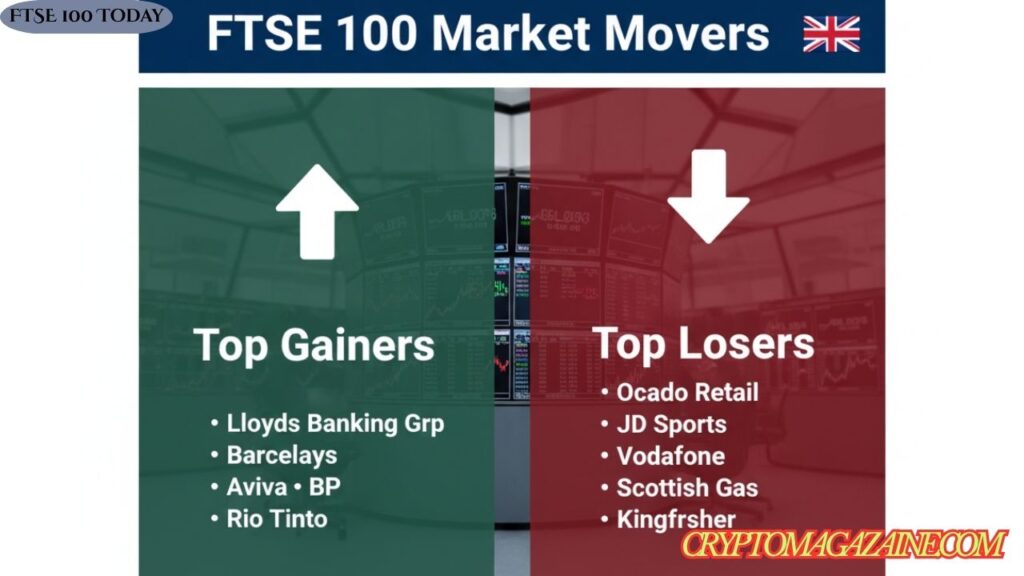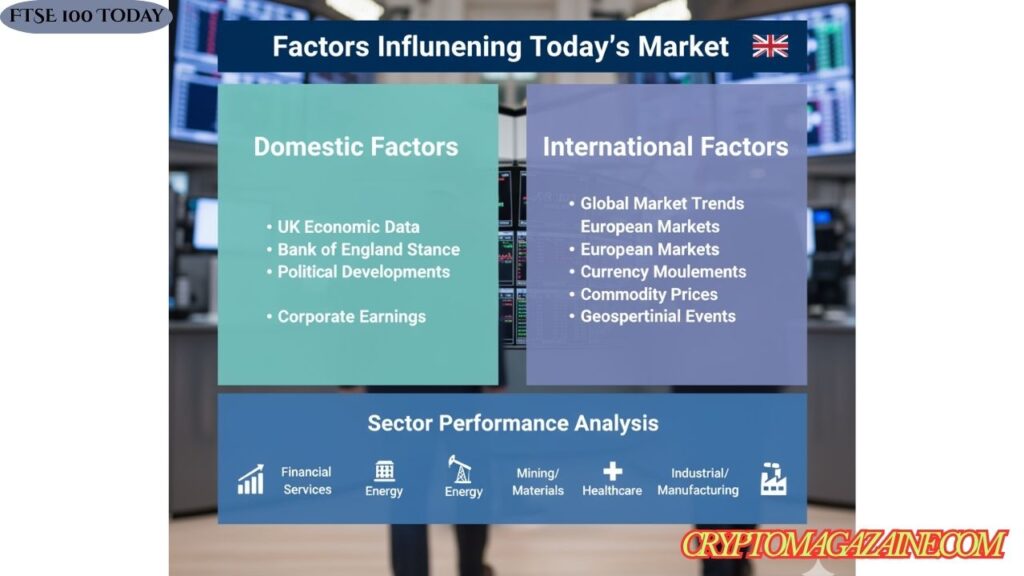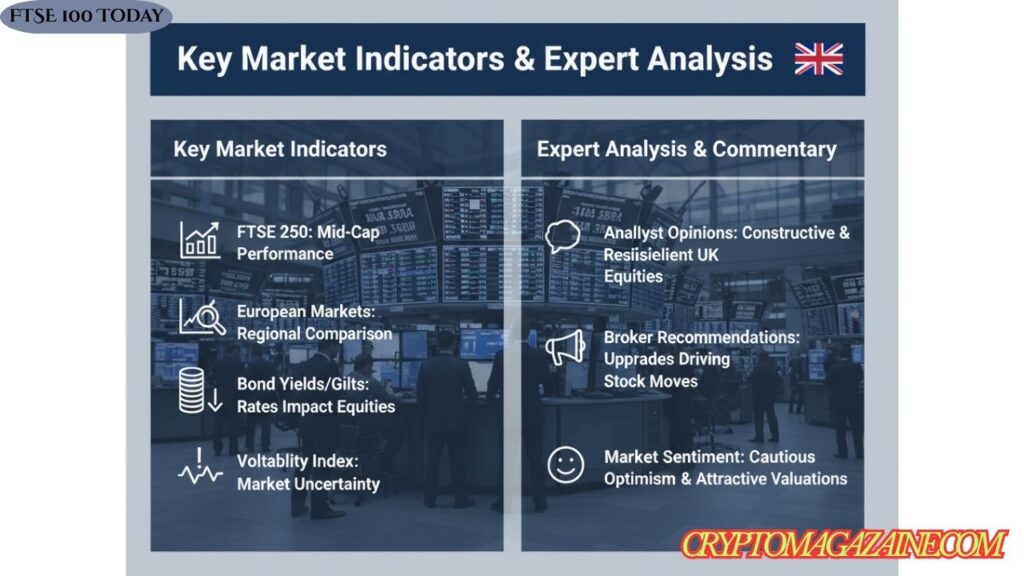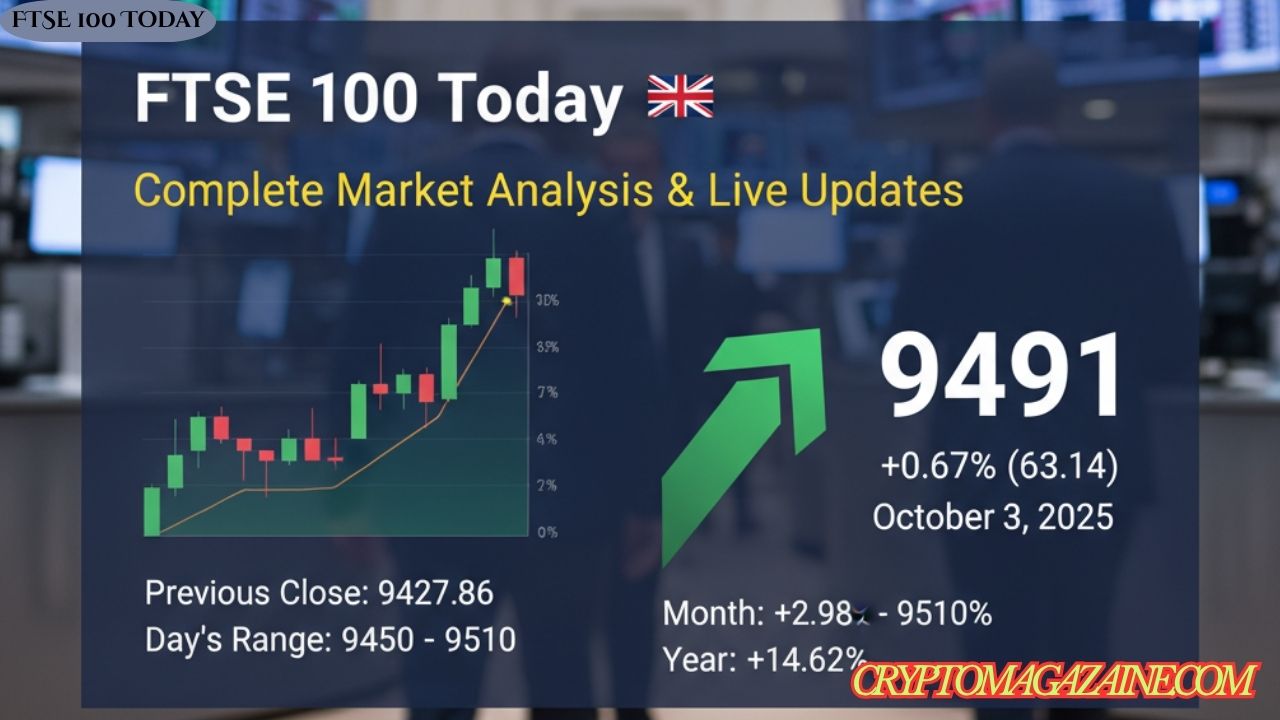Introduction
The FTSE 100, often referred to as the “Footsie,” represents the 100 largest companies listed on the London Stock Exchange by market capitalisation. This benchmark index serves as a vital barometer for the health of the UK economy and provides investors with crucial insights into market sentiment across various sectors.
Tracking the ftse 100 today has become essential for investors, traders, and financial analysts who seek to make informed decisions in an increasingly dynamic market environment. The index comprises multinational corporations spanning diverse industries, from banking and energy to pharmaceuticals and consumer goods, making it a comprehensive reflection of global economic trends.
Understanding the ftse 100 index today offers more than just numbers on a screen. It provides context for portfolio management decisions, reveals emerging market trends, and helps investors identify opportunities amid market volatility. With many constituent companies generating significant revenue internationally, the index responds to both domestic UK developments and global economic shifts.
Current FTSE 100 Performance
The ftse 100 today live performance has captured considerable attention from market participants. The index recently achieved another record high, participating in a broad rally across global stock markets. The index rose to 9491 points on October 3, 2025, gaining 0.67% from the previous session.
This upward momentum reflects improving investor confidence and favorable market conditions. The opening bell saw steady trading activity as investors digested overnight developments from Asian markets and positioned themselves ahead of key economic data releases.
Throughout the trading session, the index has demonstrated resilience, with the day’s range showcasing typical intraday volatility. Market participants have been closely monitoring price action around key technical levels, which often influence short-term trading decisions.
The net change in both points and percentage terms provides investors with immediate insight into market direction. When examining these movements, traders consider not just the magnitude of change but also the volume accompanying these moves, as higher volume typically validates price movements.
Comparing today’s performance to the previous close helps establish context for current market sentiment. Over the past month, the index has climbed 2.98% and is up 14.62% compared to the same time last year, demonstrating sustained bullish momentum that has characterized recent trading.
Year-to-date performance remains a critical metric for long-term investors assessing their portfolio returns. The strong performance suggests that UK equities have benefited from a combination of corporate earnings growth, favorable monetary policy expectations, and improving economic indicators.
Market Movers

Top Gainers
Several companies have emerged as standout performers in today’s trading session. Financial stocks have led gains, with banking giants and insurance companies experiencing notable upticks in their share prices.
The reasons behind these strong performances vary across sectors. Some companies have benefited from better-than-expected earnings reports, while others have gained ground following positive analyst upgrades or strategic announcements that have captured investor attention.
Within the financial services sector, banks have particularly thrived as interest rate expectations shift and lending margins improve. Insurance companies have also participated in this rally, supported by strong underwriting results and disciplined capital management strategies.
Energy companies have featured prominently among top gainers, responding to movements in global oil prices and strategic developments within the sector. Mining firms have also contributed to the index’s upward trajectory as commodity prices fluctuate based on supply-demand dynamics.
Top Losers
Despite the overall positive market tone, certain companies have faced selling pressure. Consumer-facing businesses dealing with discretionary spending concerns have seen their valuations challenged as investors reassess growth prospects.
Several factors have contributed to these declines. Some companies have issued profit warnings or reported weaker-than-anticipated quarterly results, triggering immediate market reactions. Others have faced headwinds from currency movements that negatively impact their international earnings.
The retail sector has experienced particular challenges, with companies sensitive to consumer confidence facing scrutiny. As household budgets remain under pressure from persistent inflation, retailers focusing on non-essential goods have encountered more difficult trading conditions.
Technology and telecommunications companies have shown mixed performance, with some facing concerns about competitive pressures and capital expenditure requirements. These sector-specific dynamics remind investors that individual stock selection remains crucial even within a rising market.
Factors Influencing Today’s Market

Domestic Factors
UK economic data releases have played a significant role in shaping market sentiment. Investors have digested recent figures on employment, inflation, and GDP growth, all of which influence expectations for future monetary policy.
The Bank of England’s stance continues to influence market dynamics. Speculation about potential interest rate adjustments affects valuations across sectors, particularly for rate-sensitive industries like banking, real estate, and utilities. Any hints from policymakers about the future trajectory of monetary policy generate immediate market responses.
Political developments in Westminster also factor into investor calculations. Government fiscal policies, regulatory changes, and broader economic strategies all contribute to the investment landscape. Recent discussions about taxation, infrastructure spending, and trade relationships have garnered attention from market participants.
Corporate earnings reports have provided company-specific catalysts. The current reporting season has revealed which businesses are successfully navigating economic headwinds and which face structural challenges. These revelations drive individual stock movements that collectively influence the broader index.
International Factors
Global market trends significantly impact the ftse 100 news today. Developments in US markets, particularly movements in major indices like the S&P 500 and Nasdaq, often set the tone for European trading sessions. Strong overnight performance in American markets typically provides a supportive backdrop for UK equities.
European market movements also correlate closely with FTSE 100 performance. Germany’s DAX and France’s CAC 40 often move in tandem with the London market, reflecting shared economic ties and investor sentiment across the continent.
Currency movements remain a critical consideration. The GBP/USD exchange rate influences the value of overseas earnings for multinational companies domiciled in the UK. When sterling weakens, these companies benefit from translation effects, potentially boosting index performance. Conversely, a stronger pound can create headwinds.
Commodity prices exert substantial influence given the index’s significant weighting toward resource companies. Oil price fluctuations directly impact energy giants, while movements in gold, copper, and other metals affect mining companies. These commodity-driven dynamics often explain significant index movements.
Geopolitical events continue to introduce uncertainty into markets. Developments in international trade relationships, regional conflicts, and diplomatic tensions can trigger volatility. Investors monitor these situations closely, adjusting positions based on perceived risk levels.
Sector Performance Analysis
The financial services sector has delivered standout performance, with banks and insurance companies driving index gains. Improved net interest margins and strong capital positions have supported valuations in this crucial segment of the market.
Energy sector performance has reflected ongoing volatility in global oil markets. Major integrated energy companies have navigated the transition toward renewable energy while maintaining strong cash flows from traditional operations. This balance has appealed to investors seeking both income and long-term growth potential.
Mining and materials companies have responded to commodity price movements. These resource-heavy businesses remain sensitive to global growth expectations, particularly demand from major economies. Supply disruptions and inventory levels also influence short-term price action.
Consumer goods companies present a mixed picture. Essential goods manufacturers have demonstrated resilience, supported by consistent demand patterns. However, luxury goods producers and discretionary retailers face more variable conditions depending on consumer confidence levels.
Healthcare and pharmaceutical firms continue attracting defensive-minded investors. The sector’s relatively stable earnings profile and innovation pipeline provide appeal during uncertain economic periods. Recent drug approvals and clinical trial results have created specific catalysts for individual companies.
Technology and telecommunications stocks have shown varied performance. While some companies benefit from digital transformation trends, others face intense competition and regulatory scrutiny. The sector remains dynamic, with innovation driving both opportunities and challenges.
Industrial and manufacturing companies reflect broader economic conditions. Order books, supply chain efficiency, and input cost management all influence performance in this diverse sector. Recent infrastructure investment announcements have provided some companies with enhanced visibility.
Key Market Indicators

The FTSE 250, representing mid-cap companies, provides additional context for understanding market breadth. Movements in this index reveal whether market strength extends beyond the largest companies or remains concentrated among blue-chip stocks.
European market indices offer valuable comparison points. When the FTSE 100 outperforms or underperforms its continental counterparts, it signals UK-specific factors at play. These relative movements help investors assess regional opportunities.
Bond yields and gilt prices maintain an inverse relationship that affects equity valuations. When yields rise, bonds become more attractive relative to stocks, potentially drawing capital away from equities. Recent movements in the gilt market reflect changing inflation expectations and monetary policy outlook.
The volatility index provides insight into market uncertainty. Lower readings suggest complacency and stability, while elevated levels indicate heightened concern about potential market swings. Monitoring this metric helps investors gauge overall market sentiment.
Expert Analysis and Commentary
Analyst opinions on today’s movements have been generally constructive. Market strategists have noted the resilience demonstrated by UK equities despite various headwinds, pointing to attractive valuations relative to historical norms and international peers.
Broker recommendations continue influencing individual stock performance. Upgrades and downgrades from major investment banks carry weight with institutional investors, often triggering immediate price reactions. The current environment has seen analysts adjust their views based on evolving economic data.
Market sentiment indicators derived from various sources paint a picture of cautious optimism. While investors recognize ongoing risks, the prevailing mood suggests that market participants believe opportunities outweigh threats at current valuation levels.
What to Watch
Upcoming economic data releases will provide fresh information for market participants to digest. Key figures on inflation, retail sales, and industrial production can significantly impact expectations for monetary policy and economic growth trajectory.
Corporate announcements scheduled in coming days include several high-profile earnings reports. These results will offer updated insights into business conditions across sectors, potentially reshaping investor views on specific companies and industries.
Central bank meetings and speeches from policymakers remain focal points. Any signals about future interest rate decisions or changes in quantitative tightening programs generate immediate market reactions. Investors parse every word from central bankers for clues about policy direction.
Potential market catalysts for tomorrow include both scheduled events and possible surprises. Geopolitical developments, unexpected economic data, or company-specific news could all introduce volatility. Maintaining awareness of these possibilities helps investors position portfolios appropriately.
Historical Context
Week-over-week comparison reveals a pattern of steady gains, with the index building on previous advances. This momentum reflects improving fundamentals and supportive technical factors that have attracted both long-term investors and shorter-term traders.
Month-over-month performance demonstrates sustained strength. The ability to maintain upward trajectory over this timeframe suggests more than just temporary enthusiasm, pointing to underlying factors supporting higher valuations.
Comparison to the same period last year highlights significant appreciation. This substantial gain reflects recovery from previous challenges and adaptation to evolving economic conditions. Companies have demonstrated operational resilience and strategic flexibility.
Notable trends include increased participation from international investors and rotation into UK equities from other markets. These patterns suggest changing perceptions about relative value and growth prospects for British companies.
Investor Implications
Today’s movements carry implications for portfolio construction and management. The strong performance across major sectors suggests broad-based confidence, though investors should remain mindful of concentration risk given the index’s large-cap focus.
Opportunities identified include sectors benefiting from structural trends and companies demonstrating pricing power amid inflationary pressures. Value-oriented investors may find appeal in certain segments that have lagged despite solid fundamentals.
Risks remain present despite positive momentum. Potential economic slowdown, geopolitical uncertainties, and valuation concerns in certain sectors warrant careful consideration. Diversification remains crucial for managing these various risk factors.
Long-term perspectives differ from short-term trading considerations. While day-to-day movements create tactical opportunities, patient investors focus on fundamental quality and sustainable competitive advantages. The ftse 100 news today live provides immediate information, but long-term success requires looking beyond daily fluctuations.
Conclusion
Today’s key takeaways reveal a market characterized by resilience and selective strength. The index’s performance reflects both global trends and UK-specific developments, with financial stocks providing particular leadership.
The market outlook for upcoming sessions depends on several factors including economic data releases, corporate earnings, and international developments. The current technical picture suggests potential for continued gains, though consolidation periods remain possible.
Overall market health appears sound based on breadth indicators and sector participation. While no market moves in a straight line, the underlying fundamentals supporting current valuations suggest that investors retain confidence in the growth prospects for UK-listed companies.
Staying informed about the ftse 100 today requires monitoring multiple information sources and understanding the complex interplay of factors driving market movements. Whether tracking live updates throughout the trading day or reviewing closing summaries, maintaining awareness of index performance helps investors navigate their financial journey with greater confidence and clarity.
For more Updates: Crypto Magazaine






